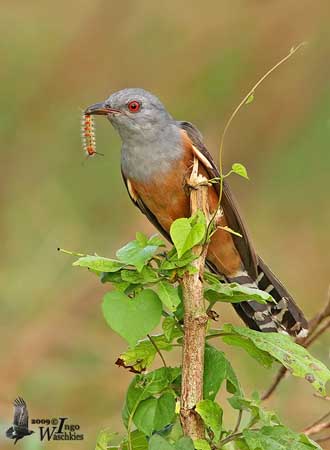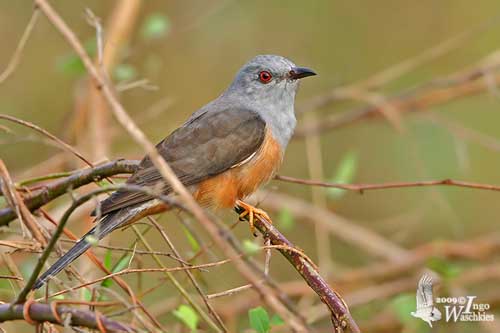
Fr: Coucou plaintif
All : Klagekuckuck
Esp : Cucu Plañidero
Ital : Cuculo lamentoso
Nd: Klaagkoekoek
Sd: Gråbröstad buskgök
Photographer:
Ingo Waschkies
Bird Photography
Text by Nicole Bouglouan
Sources:
HANDBOOK OF THE BIRDS OF THE WORLD vol 4 by Josep del Hoyo-Andrew Elliott-Jordi Sargatal - Lynx Edicions - ISBN: 8487334229
A Field Guide to the Birds of South-East Asia by Craig Robson. New Holland Publishers. ISBN: 9781780090498
BirdLife International (BirdLife International)
Wikipedia, the free encyclopaedia
Plaintive Cuckoo
Cacomantis merulinus
Cuculiforme Order – Cuculidae Family
BIOMETRICS:
Length: 18-24 cm
Weight: 22-25 g
DESCRIPTION:
As numerous cuckoos, the Plaintive Cuckoo is a brood parasite. It favours the closed nests with narrow entrance, built by small passerines such as ioras, prinias, cisticolas and taylorbirds. This is a fairly small cuckoo.
The adult male of nominate race has pale grey head, upper mantle, neck, chin, throat and breast.
The upperparts are grey-brown but the upperwing is rather dark greyish-brown. The tail is dark grey-brown with narrow white tip.
The rest of the underparts are pale rufous from upper belly to undertail-coverts. The undertail feathers are dark grey barred whitish. On the underwing, the wing-coverts are pale rufous whereas the flight feathers are pale whitish-grey.
The bill is blackish. The eyes are red. Legs and feet are brown-orange.

The female may sometimes resemble male but she often shows a “hepatic” (reddish-brown) morph with rufous or reddish-brown upperparts barred black. The underparts are paler with indistinct dark barring. The undertail is barred whitish as in male.
The head is pale rufous-brown, paler than upperparts but slightly darker than underparts. We can see an indistinct paler supercilium.
The bill is black with paler base of lower mandible. The eyes are brown. Legs and feet are pale brown-orange.
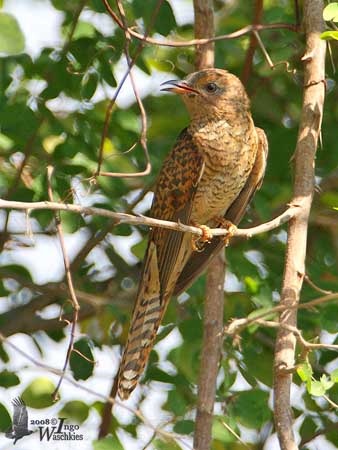
The juvenile may have variable plumage, with grey or rusty-brown tones, and more streaked head and upper breast.
The immature resembles adults with duller plumage.
We can find five subspecies which differ mainly in plumage tones.
VOICE: SOUNDS BY XENO-CANTO
The Plaintive Cuckoo’s calls are usually heard in the morning and the evening. It utters a rising song of 3 notes “pii-pi-pui”. This phrase is repeated and gradually accelerates, followed by rapid and descending notes.
The male’s territorial song is a plaintive series of high-pitched whistles “tee-tee-tee-tee-tita-tita-tita-tita-tee” described as 4 slow notes followed by 4 more rapid notes.
The female gives some calls such as “piteer” or “tchree”.
The Indian race C.m. passerinus utters a plaintive piping whistle “ka-veer”.
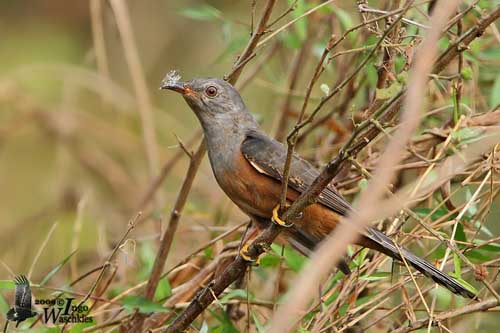
HABITAT:
The Plaintive Cuckoo frequents a fairly wide variety of habitats such as open woodlands and secondary forest, scrub and brush, cultivated fields and gardens in both rural and urban areas. It may be found in grassland and swamps too.
This species is visible from lowlands up to 1400-2000 metres of elevation according to the range.
RANGE:
The Plaintive Cuckoo of nominate race here described and displayed, occurs in the Philippines. The other races, passerinus, querulus, threnodes and lanceolatus share the wide range in NE India, Bangladesh, SE Tibet, S China, Greater Sundas, Philippines and Sulawesi.
BEHAVIOUR:
The Plaintive Cuckoo feeds on insects, and primarily hairy caterpillars, but sometimes also hairless ones. Insects include beetles, bugs, termite soldiers and other soft-bodied species. It may take some fruits too.
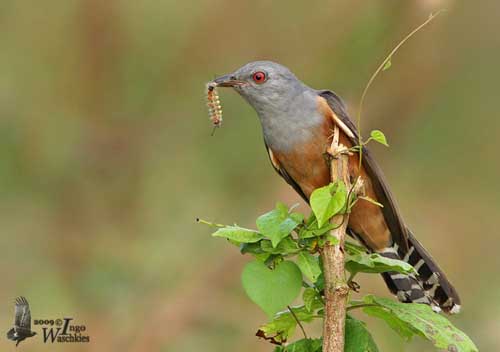
It forages in the foliage at canopy-level. It is often very active when searching for food. It also forages in scrub and brush where it moves about restlessly.
The Plaintive Cuckoo is a brood parasite. The courtship displays are poorly known, but several cuckoo species spread and raise the tail, in order to expose the plumage pattern.
This species lays its eggs into the nests of other birds, named hosts. These birds become the foster parents of the young cuckoo. But the hosts often mob the cuckoos and drive them away from the nest-site.
This species is mainly resident in its range, but seasonal movements are observed.
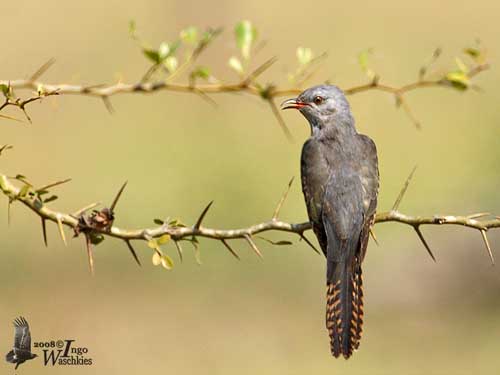
FLIGHT:
The Plaintive Cuckoo has fairly rapid and undulating flight.
REPRODUCTION:
Usually, the female cuckoo watches the future hosts from a concealed perch. She even visits the nest when the owners are away feeding, and lays her egg into this nest. The laying occurs before the beginning of the incubation. Then, the female cuckoo flies away from the host nest, often with an egg in the bill, and she consumes it later.
But sometimes, she remains perched on the rim and consumes egg after egg. This additional food provides her minerals, and helps her to form her own eggs. Later, the female cuckoo lays her eggs while crouched in the nest, or on the rim, or perched above the cup too. But when the host’s nest is situated in holes or closed, she lays without entering completely the nest.
Once hatched, the chick cuckoo often pushes the other eggs or chicks from the nest. The foster parents give all the parental care to the cuckoo, and the young grows rapidly, fed with the food normally delivered to a complete brood.
The female Plaintive Cuckoo often chooses the nests of Common Ioras, Ashy prinias, Common Tailorbirds, Zitting Cisticolas and other members of these families, according to the location.
Her eggs are light buff to green with pale olive markings. They usually are very similar to the host’s eggs.
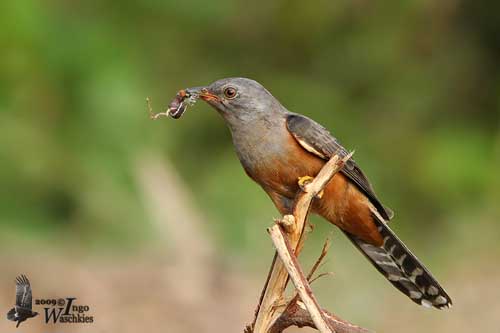
DIET:
The Plaintive Cuckoo feeds on insects such as beetles, bugs, termites and numerous soft-bodied species, but it feeds primarily on hairy caterpillars (Saturnidae) and some hairless ones (Notodontidae). It may take some fruits too.
This is a very active and restless foraging bird.
PROTECTION / THREATS / STATUS:
The Plaintive Cuckoo is fairly common throughout most of its range.
This species is not currently threatened.
